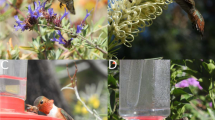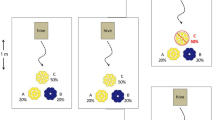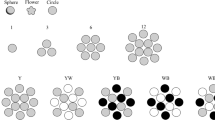Abstract
Pollinators possess several antipredator adaptations that minimise predation risk during foraging. In addition to morphological adaptations, hoverflies might have behavioural antipredator adaptations. We conducted three field experiments to investigate whether the “hesitation behaviour” of hoverflies Sphaerophoria spp., moving backwards and forwards in front of a flower, is effective in avoiding ambush predators on flowers. First, we compared the behaviour of different flower visitors, including several bees and other hoverflies, with Sphaerophoria spp. behaviour. Only Sphaerophoria spp. exhibited the hesitation behaviour in front of flowers. The flight behaviour was observed more frequently before landing on flowers than on leaves. Second, we investigated rejection by Sphaerophoria spp. to artificially placed corpses of the crab spider Thomisus labefactus. The rejection rate of flowers with a crab spider placed on or under it was significantly higher than that of non-treated flowers. Moreover, the presence of a spider on the flower decreased the number of hesitation displays, compared with non-treated flowers. Finally, to determine whether hesitation behaviour could be a consequence of floral assessment, we investigated hoverfly rejection of previously foraged flowers. Sphaerophoria spp. did not reject flowers that had been visited by the same individual or conspecifics within 3 min. We suggest that hesitation behaviour may be adaptive, enabling assessment of predation risk and hence avoiding ambush predators on flowers.




Similar content being viewed by others
References
Ambrose JT (1990) Birds. In: Morse RA, Nowogrodzki R (eds) Honeybee pests, predators, and diseases. Cornell University Press, Ithaca, pp 156–176
Asahina S, Ishihara T, Yasumatsu K (1965) Iconographia insectorum Japonicorum colore naturali edita volumen III. Hokuryu-kan, Tokyo
Caron DW (1990) Other insects. In: Morse RA, Nowogrodzki R (eds) Honeybee pests, predators, and diseases. Cornell University Press, Ithaca, pp 156–176
Chittka L (2001) Camouflage of predatory crab spiders on flowers and the colour perception of bees (Aranida: Thomisidae/Hymenoptera: Apidae). Entomol Gener 25:181–187
De Jong D (1990) Insects: Hymenoptera (ants, wasps, and bees). In: Morse RA, Nowogrodzki R (eds) Honeybee pests, predators, and diseases. Cornell University Press, Ithaca, pp 135–155
Dukas R (1998) Evolutionary ecology of learning. In: Dukas R (ed) Cognitive ecology. University of Chicago Press, Chicago, pp 129–274
Dukas R (2001a) Effects of perceived danger on flower choice by bees. Ecol Lett 4:327–333
Dukas R (2001b) Effects of predation risk on pollinators and plants. In: Chittka L, Thomson JD (eds) Cognitive ecology of pollination. Cambridge University Press, New York, pp 214–236
Dukas R (2005) Bumble bee predators reduce pollinator density and plant fitness. Ecology 86:1401–1406
Dukas R, Morse DH (2003) Crab spiders affect flower visitation by bees. Oikos 101:157–163
Dukas R, Morse DH (2005) Crab spiders show mixed effects on flower visiting bees and no effect on plant fitness. Ecoscience 12:244–247
Evans HE, Eberhard JW (1970) The wasps. University of Michigan Press, Ann Arbor
Golding YC, Edmunds M (2000) Behavioural mimicry of honeybees (Apis mellifera) by droneflies (Diptera: Syrphidae: Eristalis spp.). Proc R Soc Lond B 267:903–909
Golding YC, Ennos AR, Edmunds M (2001) Similarity in flight behaviour between the honeybee Apis mellifera (Hymenoptera: Apidae) and its presumed mimic, the dronefly Eristalis tenax (Diptera: Syrphidae). J Exp Biol 204:139–145
Golding YC, Edmunds M, Ennos AR (2005) Flight behaviour during foraging of the social wasp Vespula vulgaris (Hymenoptera: Vaspidae) and four mimetic hoverflies (Diptera: Syrphidae) Sericomyia silentis, Myathropa florea, Helophilus sp. and Syrphus sp. J Exp Biol 208:4523–4527
Goulson D, Wright NP (1998) Flower constancy in the hoverflies Episyrphus balteatus (Degeer) and Syrphus ribesii (L.) (Syrphidae). Behav Ecol 9:213–219
Goulson D, Chapman JW, Hughes WOH (2001) Discrimination of unrewarding flowers by different bee species; direct detection of rewards and use of repellent scent marks. J Ins Behav 14:669–678
Greco CF, Kevan PG (1995) Patch choice in the anthophilous ambush predator Phymata americana: improvement by switching hunting sites as part of the initial choice. Can J Zool 73:1912–1917
Heiling AM, Herberstein ME, Chittka L (2003) Crab-spiders manipulate flower signals. Nature 421:334
Howarth B, Clee C, Edmunds M (2000) The mimicry between British Syrphidae (Diptera) and aculeate Hymenoptera. Br J Ent Nat Hist 13:1–39
Howarth B, Edmunds M, Gilbert F (2004) Does the abundance of hoverfly (Syrphidae) mimics depend on the numbers of their hymenopteran models? Evolution 58:367–375
Lunau K, Hofmann N, Valentin S (2005) Response of the hoverfly species Eristalis tenax towards floral dot guides with colour transition from red to yellow. Entomol Gener 27:249–256
Minckley RL, Roulston TH (2006) Incidental mutualisms and pollen specialization among bees. In: Waser NM, Ollerton J (eds) Plant–pollinator interactions from specialization to generalization. University of Chicago Press, Chicago, pp 69–98
Miyashita K (1999) Life history of Thomisus labefactus Karsch (Araneae: Thomisidae). Acta Arachnol 48:143–149
Morse DH (1979) Prey capture by the crab spider Misumena calycina calycina (Araneae: Thomisidae). Oecologia 39:309–319
Morse DH (1986) Predation risk to insects foraging at flowers. Oikos 46:223–228
Pianka ER (1974) Evolutionary ecology. Harper and Row, New York
Proctor M, Yao P, Lack A (1996) The natural history of pollination. Timber, Portland
Reader T, Higginson AD, Barnard CJ, Gilbert FS (2006) The effects of predation risk from crab spiders on bee foraging behavior. Behav Ecol 17:933–939
Robertson IC, Maguire DK (2005) Crab spiders deter insect visitations to slickspot peppergrass flowers. Oikos 109:577–582
Saleh N, Chittka L (2006) The importance of experience in the interpretation of conspecific chemical signals. Behav Ecol Sociobiol 61:215–220
Saleh N, Ohashi K, Thomson JT, Chittka L (2006) Facultative use of repellent scent mark in foraging bumblebees: complex vs. simple flowers. Anim Behav 71:847–854
Stout JC, Goulson D (2002) The influence of nectar secretion rates on the responses of bumblebees (Bombus spp.) to previously visited flowers. Behav Ecol Sociobiol 52:239–246
Sutherland JP, Sullivan MS, Poppy GM (1999) The influence of floral character on the foraging behaviour of the hoverfly, Episyrphus balteatus. Entomol Exp Appl 93:157–164
Théry M, Casas J (2002) Predator and prey views of spider camouflage. Nature 415:133
Yokoi T, Goulson D, Fujisaki K (2007) The use of heterospecific scent marks by the sweat bee Halictus aerarius. Naturwissenschaften 94:1021–1024
Acknowledgements
We are grateful to D. Goulson, University of Stirling, for his careful proofreading of the manuscript. We thank P. J. Perez-Goodwyn and members of the Laboratory of Insect Ecology, Kyoto University, for helpful comments on and critiques of an early draft of the manuscript. We are also grateful to I. Kandori and T. Kurosaki, Kinki University, for valuable advice. This study was partly supported by a Grant-in-Aid for the 21st century COE program for Innovative Food and Environmental Studies Pioneered by Entomomimetic Sciences from the Ministry of Education, Culture, Sports, Science and Technology, Japan.
Author information
Authors and Affiliations
Corresponding author
Rights and permissions
About this article
Cite this article
Yokoi, T., Fujisaki, K. Hesitation behaviour of hoverflies Sphaerophoria spp. to avoid ambush by crab spiders. Naturwissenschaften 96, 195–200 (2009). https://doi.org/10.1007/s00114-008-0459-8
Received:
Revised:
Accepted:
Published:
Issue Date:
DOI: https://doi.org/10.1007/s00114-008-0459-8




